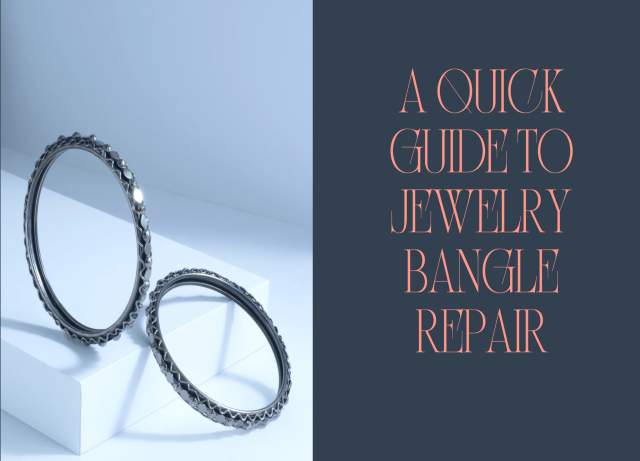You’re browsing your favorite online jewelry store when you spot the perfect bangle. You add it to your cart and complete the purchase without a second thought. A few months later, the bangle is starting to lose its shine. You take it to your local jeweler for a repair and are quoted a price that’s way more than you expected.
What do you do?
Instead of paying more than you need to, why not try repairing the bangle yourself? Don’t be discouraged! You can save a lot of money by doing your jewelry repairs at home. With a bit of patience and the right tools, you can get your bangle looking as good as new in no time. This quick and easy guide will show you how to do just that.
First, you’ll need to gather a few supplies. You’ll need a small hammer, a pair of needle-nose pliers, a set of small files, and some fine sandpaper. You’ll also need a strong adhesive, like super glue or epoxy. You’ll also need some metal polish if your bangle is gold or silver.
It might seem daunting, but with this guide, it can be easy and affordable. You can have your bangle manufacturers in India look as good as new in just a few simple steps.
What Tools Do I Need for Jewelry Bangle Repair?
Before you start, you’ll need a few essential tools:
- wire cutters
- chain nose pliers
- round nose pliers
- jewelry hammer
These will help you remove and fix broken links, straighten bent links, and replace missing or broken links. You’ll also need some beading wire and jump rings in the same gage as your bangle. Beading wire is thinner and more flexible than regular wire, so it’s easier to work with. And jump rings are small metal loops that you can use to attach new links to your bangle.
How to Measure for a Perfect Fit
Before you even start looking for a repair kit, you need to take the time to measure your bangle for a perfect fit. This is essential because if the kit is too big or too small, it could do more damage than good.
Here’s how to measure: using a soft measuring tape, measure the diameter of your bangle at its widest point. If you don’t have a soft measuring tape, you can use a piece of string or dental floss to get the exact measurement. Then, compare your results to the size chart on the repair kit packaging.
Match your measurement to the closest size on the chart, and that’s the size you’ll need for your kit.
How to Replace a Broken Clasp
If your bracelet clasp is broken, you can easily replace it at home. Here’s how:
1. Remove the old clasp from the bracelet. You may need to use a pair of pliers to do this.
2. Cut a new clasp to the same size as the old one, ensuring that it is long enough to fit through the holes in the bracelet.
3. Attach the new clasp to the bracelet using glue or superglue.
4. Allow the glue to dry completely before wearing your bracelet again.
If your bracelet is made of valuable materials, you should take it to a professional jeweler to have the clasp replaced.
How to Fix a Scratched or Chipped Stone
If you’ve got a stone scratched or chipped, you’ll want to fix it ASAP. The good news is this is a pretty easy fix.
- First, you’ll want to gather up a few supplies. You’ll need a toothpick, super glue, a cotton swab, and a jewelry polishing cloth.
- Start by cleaning the area around the scratch with the cotton swab. Then, apply a small amount of super glue to the toothpick and use it to fill in the scratch. Be careful not to use too much glue—you don’t want it to seep from under the stone.
- Once the glue has dried, use the polishing cloth to buff out any excess, and voila! Your stone will look as good as new.
How to Clean Tarnished Silver or Gold Bangles
- The first step is to line a bowl with aluminum foil. You’ll want to use about a foot of foil for every bangle you plan to clean.
- Next, you’ll need to add enough hot water to cover the bangles, and then mix in 1/4 cup of baking soda for every gallon of water.
- Once the bangles are in the mixture, let them soak for about 10 minutes. After that, please remove them and rinse them off with cold water.
- If your bangles are still tarnished, you can repeat this process. Otherwise, dry them off and enjoy your sparkling jewelry!
How to Prevent Future Damage to Your Bangles
The best way to avoid having to repair your bangles is to prevent damage from happening in the first place. Here are some tips on how you can do that:
- Always take your bangles off before showering or swimming. The chemicals in shampoo, conditioner, soap, and chlorine can cause metals to tarnish and weaken.
- Avoid contact with perfumes, lotions, and oils. These can also cause metals to tarnish.
- Don’t wear your bangles while doing activities that could damage them, like gardening, cooking, or working out.
- Store your bangles in a cool, dry place from direct sunlight. A jewelry box or pouch is ideal.
- When you’re not wearing them, keep your bangles separated, so they don’t rub together and scratch each other.
Following these simple tips can help keep your bangles in good condition and avoid the need for jewelry bangle repair.
How Do I Know if My Bangle Is Damaged?
If you think your bangle might be damaged, the best way to find out is to take it to a professional jeweler and have them look at it. They’ll surely tell you if it’s damaged and what needs to be done to fix it.
There are a few things you can look for yourself, though. If your bangle is bent, twisted, or otherwise out of shape, that’s a sign that it’s been damaged and will need to be repaired.
Any cracks or chips in the metal or stone are also a sign that it needs to be repaired. And finally, if the clasp doesn’t work correctly or is broken, you’ll need to get it fixed. If you need to check whether or not your bangle is damaged, it’s always best to err on the side of caution and take it to a professional jeweler to check it out.
What Are the Most Common Damages to Bangles?
The most common damages to bangles are scratches, dents, and bends. While light scratches can often be buffed out, deeper ones will need to be repaired by a professional. Dents can also usually be removed with careful polishing, but if the dent is too severe, the bangle will need to be replaced.
READ MORE: How Much Does Custom Jewelry Cost?
Bends are the most challenging damage to fix, as they usually require the bangle to be reheated and reshaped. This is a delicate process that a professional jeweler should only do. If your bangle is severely damaged, it is best to take it to a jeweler for repair. However, if the damage is minor, you may be able to fix it yourself.
Conclusion
So, there you have it! A quick and easy guide to jewelry bangle repair. With time and effort, you can have your jewelry looking as good as new in no time. We hope you found this guide helpful and that you now feel confident tackling your jewelry repair projects. If you have any questions or comments, please feel free to leave them below. We would love to hear from you! If you enjoyed this article, please share it with your friends or family. And don’t forget to check our other jewelry repair guides for helpful tips and tricks.





